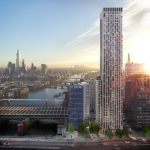As part of the City of London Corporation’s ongoing review of its Local Plan it has commissioned various reports which provide a fascinating insight into the future of City offices and space requirements going forward. In the papers reviewed by the Local Plan Sub Committee (Tuesday 20 June), there are references to two reports focusing on:
- Future of Office Use
- Tall Buildings and Heritage
These short reports provide interesting reading. I briefly summarise the key highlights below:
The Future of Office Use committee report includes an appendix of an Executive Summary of the much-anticipated Arup/ Knight Frank Future of the Office Use report. The full report is expected to be published imminently. The Arup study has considered whether the impacts of the Pandemic result in different and longer-term impacts on working patterns and the likely need and demand for office floorspace. The Arup report outlines three potential scenarios for the demand of office floorspace in the City. The scenarios consider different hybrid working patterns and the changing office characteristics such as the focus on quality of space and amenities.
The three scenarios are:
- Return of In-Person assumes that pre-pandemic working habits resume, with most of workers coming back to the office (at 80% of 2019 levels), with a slight preference for mid-week days
- Hybrid Peak sees office workers coming around 2.5 days a week (65% of 2019 levels) with a high concentration between Tuesday and Thursday and rather empty offices the rest of the week
- The New Diverse City scenario projects lower attendance (50% of 2019 levels) but with a more even dispersion of workers throughout the week, allowing for optimization of office space and space in excess being taken over by new entrant firms
In terms of office floorspace requirements, the three scenarios would require different amounts of office space by 2042, as follows:
- Return of In-Person requires 1.8 million m2 (20 million ft2)
- Hybrid Peak requires 1.2 million m2 (13 million ft2)
- New Diverse City requires 550,000 m2 (6 million ft2)
The Arup report notes that current office occupancy and movement trends are showing a middle ground between the Return of In-Person and Hybrid Peak, with occupancy and movement trends showing a move towards a 4 day in person work week. The Committee Report notes that these two scenarios are broadly aligned with the draft City Plan 2040 targets in regard to net office space required. It adds:
Whilst it is for Members to consider on Tuesday, the Officer Reports concludes:
The Tall Buildings Committee Report set out that officers have undertaken extensive search and evidence work related to tall buildings in the Square Mile, in particular in respect of comments from the Mayor of London, Historic England and the Cathedral arising from the 2021 Regulation 19 consultation.
As part of the research, the City officers have undertaken a comprehensive ‘sieving exercise’. The report notes:
This involved carrying out a detailed character and heritage significance assessment for the Square Mile as a whole, and then at a more granular level further sensitivity analysis for identified distinct Character Areas of the City. The study confirmed the City’s long-term approach that, given its historic nature, and the area’s prominence in local and wider views, all parts of the Square Mile are sensitive to tall building development. However, through the sieving exercise it has been possible to assess varying levels of sensitively across the City and identify those areas which have the greatest sensitivity to the potential impact of tall buildings.
Of the nine character areas identified and assessed, seven areas were identified as being ‘very sensitive’ to tall buildings, and were therefore ‘sieved out’. Two areas – specifically the City Cluster and Holborn and Fleet Valley areas – were found to be ‘sensitive’. These two areas were subjected to detailed 3D modelling sensitivity analysis to refine the extent of their perimeter boundaries and determine acceptable building heights within these areas. This work has been undertaken using VU City and Miller Hare (working closely with officers).
The Committee Report sets out that as a result of the analysis, there is a requirement to revise the City Plan draft policy on tall buildings. The updated policy will designate areas within the City where tall building development (over 75m AOD) is considered appropriate, based on the evidence base analysis. These areas will be clearly marked on the policies map, and this is an issue picked up by the Architects Journal here (£).
This is a shift in policy, with the current draft policy only identifying areas where tall buildings would be inappropriate. The new policy will provide further clarification that new tall buildings will only be appropriate in suitable locations within the designated tall building areas and will be subject to detail site assessments to ensure that they are in compliance with the tall buildings and other relevant local plan policies. Outside the designated areas, policy will be amended to specify that these areas have been identified as being ‘very sensitive’ to tall buildings and that new tall buildings would be inappropriate in these areas. The revised policy will indicate building heights on contour maps, and any tall building proposal will have to consider the maximum permissible building heights (in metres AOD) specified on the 2D contour map. A 3D digital model of the tall building areas and potential heights within them will also be made available to guide development proposals for tall buildings.
Bevis Marks synagogue
The last part of the Committee Report focuses on Bevis Marks Synagogue and notes that representatives of the synagogue community have raised concern that further development in the surrounding area could worsen the internal light levels experienced by the building and affect the historic setting of the building. It states that Officers consider that there are a range of steps that could be taken to ensure that new development in the area has an acceptable impact on the setting and therefore significance and includes the following, for Member discussion:
- Identifying an ‘Immediate Setting’ area for the synagogue, which recognises the relationship between the synagogue building, its courtyard and those buildings immediately surrounding it and which will require the height of any development to respect and respond to the immediate setting of the Synagogue, avoid having an overbearing impact and conserve the special interest of the synagogue.
- Including in City Plan policy a requirement that development within the City Cluster would not have an unacceptable impact (in line with BRE guidance) on daylight levels in historic places of worship including the Synagogue, including cumulatively, and that developments should seek to improve daylight levels where possible.
The report also notes that as a separate issue, an assessment is being carried out for establishing a conservation area covering the wider Creechurch area, recognising the significance of the many heritage assets in the area, including Bevis Marks synagogue. This process sits alongside the Local Plan, as a result of the City Corporation’s duties set out in section 69(2) of the Planning (Listed Buildings and Conservation Areas) Act 1990, which requires local planning authorities to determine whether any areas should be designated as conservation areas, and will be a matter for consideration by the Planning and Transportation Committee in July 2023.


